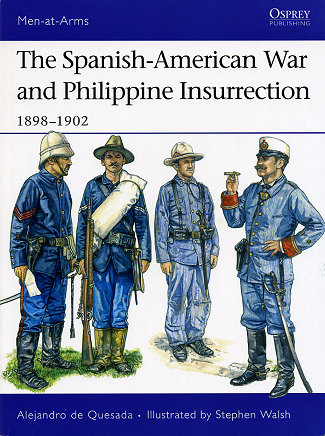 Those
who are familiar with the Men at Arms series realize that these are books
basically about uniforms and personal equipment. #437 is no different and covers
the period of America's first overseas war.
Those
who are familiar with the Men at Arms series realize that these are books
basically about uniforms and personal equipment. #437 is no different and covers
the period of America's first overseas war. |
Title: |
The Spanish-American War and Philippine Insurrection |
|
Author: |
Alejandro de Quesada, illustrated by Stephen Walsh |
|
Publisher/Distributor |
Osprey Publishing |
|
Price |
$15.95 MSRP |
|
Reviewer: |
|
| Notes: |
48 pages, 7¼ x 9¼
inches, softbound ISBN: 978-1-84603-124-3 |
 Those
who are familiar with the Men at Arms series realize that these are books
basically about uniforms and personal equipment. #437 is no different and covers
the period of America's first overseas war.
Those
who are familiar with the Men at Arms series realize that these are books
basically about uniforms and personal equipment. #437 is no different and covers
the period of America's first overseas war.
The book starts with a brief history of the major points in the Spanish-American War, a war that was pretty well trumped up by Randolph Hearst, the newspaper magnet. It didn't help that there was a coal dust explosion on the USS Maine that was attributed in Hearst's newspapers to Spanish treachery. The result was a deterioration of relations between the US and Spain and the declaration of war.
It was a war that the US wasn't ready for, as its army was pitifully small. Fortunately, the Spanish were not really in any condition to mount a formidable opposition. The few land actions were taken by state reserve units and a huge influx of volunteers. So many that the army was unable to properly equip them. There were cavalry units without horses and most used obsolescent Springfield rifles that used black powder cartridges. On the other hand, the Spanish army units were predominately made up of locals with few European Spaniards in the ranks. The results were inevitible.
Meanwhile, more skullduggery regarding the Spanish possession of the Philippine Islands. The local uprising supported and encouraged American efforts to remove the Spanish only to be shafted when the US-Spanish peace treaty turned the islands over to the US. From one master to another. This, of course, did not sit well with the insurgents and so started more years of fighting, this time against Americans instead of Spaniards.
Throughout the book the author and illustrator have shown the uniforms and equipment used by the men fighting in both Cuba and in the Philippines. Because of the nature of the climate, the clothing is similar for the Americans, but more relaxed when used in the humidity of the Pacific. Both Spanish and organized Philippine resistance armies wore uniforms best suited to the conditions.
Thanks to the excellent choice of photographs and the superb illustrations, we get an idea of how these men (and women) were dressed and outfitted. This all makes yet another great addition to the superb library of Osprey titles and one you can purchase with confidence.
March 2007
For more on the complete line of Osprey books, visit www.ospreypublishing.com. In the US, it is Osprey Direct at 44-02 23rd St, Suite 219, Long Island City, NY 11101., where you can get a catalogue of available books.
If you would like your product reviewed fairly and quickly by a site that has nearly 350,000 visitors a month, please contact me or see other details in the Note to Contributors.